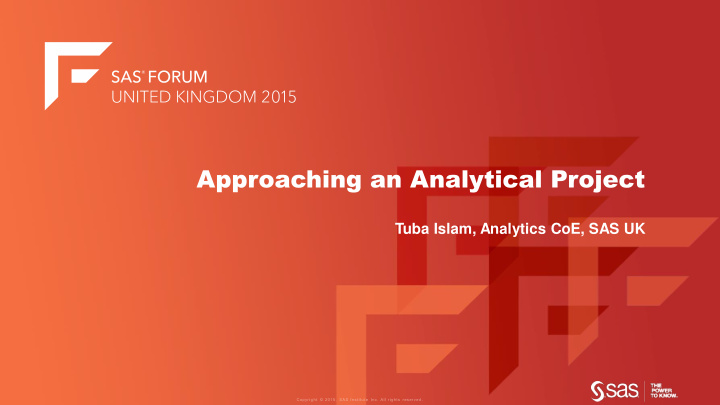



Approaching an Analytical Project Tuba Islam, Analytics CoE, SAS UK
Approaching an Analytical Project Starting with questions.. • What is the problem you would like to solve? • Why do you think analytics would help? • Which methods you would like to apply? • How are you going to turn the outcomes into decisions?
Defining the business case Not necessarily the same… • You may have a known problem to solve • High churn rate, low campaign response • You may be looking for an unknown • Fraud analysis, cyber attack • You may need to understand your customers’ preferences • Customer segmentation, affinity analysis • You may have a new data source to analyse • Smart metering data, social media, call centre records
Defining the business case Sometimes you can have more than one question to ask… • How can you improve the profitability of your organisation? • Who are the most profitable customers? • Which of these customers are going to churn? • What would be the best offer to retain these customers?
Examples of Use Cases Response Modeling Cross and Up Selling Churn Prediction Customer Segmentation KPI Forecasting Customer Lifetime Value Web Mining Credit Scoring Fraud Detection Marketing Optimization Market Basket Analysis Customer Link Analytics Social Media Analytics Location Analysis Marketing Mix Analysis
The analytical approach is chosen based on the business question Classification Supervised Prediction Analytical Methods Clustering Unsupervised Affinity Analysis Semi Supervised Social Network Analysis
Approaching an Analytical Project Basic Steps # 5 # 4 Execute # 3 and take Build an actions analytical # 2 Create an process analytical # 1 Collect the data mart relevant Design an information integrated business solution
Step 1. Design an integrated solution to increase the value gained from analytics
Step 2. Collect the relevant information The relevancy of the data source may be different for each business question
Step 3. Create an analytical data mart • The analytical transformations may be different for each model • Training data mart • For a predictive model, decide on the reference date to take the snapshot of the historical data and exclude the prediction window • Aggregate the data to summarise the information in the entity level (customer ID, account ID etc.) • Rename the input variables dynamically to represent the recency and avoid the dependency on time (eg. M1: last month, M2: previous month, W1: last week) • Create a target variable (eg. churner, fraudulent) from the prediction window M3 M2 M1 MX1 • Scoring data mart Action • Create a scoring dataset from the up-to-date source data and include the Window Observation Window Prediction Window variables that are used as input in the production model.
Step 4. Build an analytical process • Select the population for the model • Apply eligibility rules (eg. no credit risk history, no purchase of the campaign offer) • Apply the SEMMA methodology (Sample, Explore, Modify, Model, Assess) to create the model • Partition the data as train and test • Take a stratified sample of the data if the event rate is rare (e.g. change 5/100 to 20/100) • Transform the data to remove outliers, impute missings, maximise normality etc. • Try different techniques to build models and select the best one to deploy • Save/register the model
Step 5: Execute models and take actions • Extract the scoring code and run it on the production data to score new customers • Real-time, near real-time or batch execution (e.g application scoring in real-time, churn scoring weekly) • If there is an optimisation problem with some constraints then use the model scores as input variables for the optimisation engine and find the best outcome to take actions. • After the deployment of the models, collect the actuals from the operational system and write them back to the analytical data mart for monitoring performance and retraining models. If the performance drops below a threshold then the model gets retired or retrained. • Integrate the outcomes with the existing systems to take actions on time and make the highest profit.
Use Case: Building an analytical process in SAS Enterprise Miner and SAS Decision Manager • How can you improve the profitability of your organisation? • Who are the most profitable customers? • Which of these customers are going to churn? • What would be the best offer to retain these customers?
Building Models in SAS Enterprise Miner • The churn behaviour would differ for different customer profiles. • Building profit based homogeneous segments and then creating predictive models for individual segments could improve the accuracy of the models
Monitoring and Maintaining in SAS Decision Manager • Churn models and propensity models are imported in SAS Decision Manager, a centralised model management environment. • Performance reports are created automatically and the changes in the output and also the input variables are monitored. • The models are retrained if the performance decreases beyond a pre-defined threshold. Models can also be published in-database to eliminate data movements from the data source to the analytics server.
Approaching an Analytical Project # 5 # 4 Execute # 3 and take Build an actions analytical # 2 Create an process analytical # 1 Collect the data mart relevant Design an information integrated business solution
www.SAS.com
Recommend
More recommend